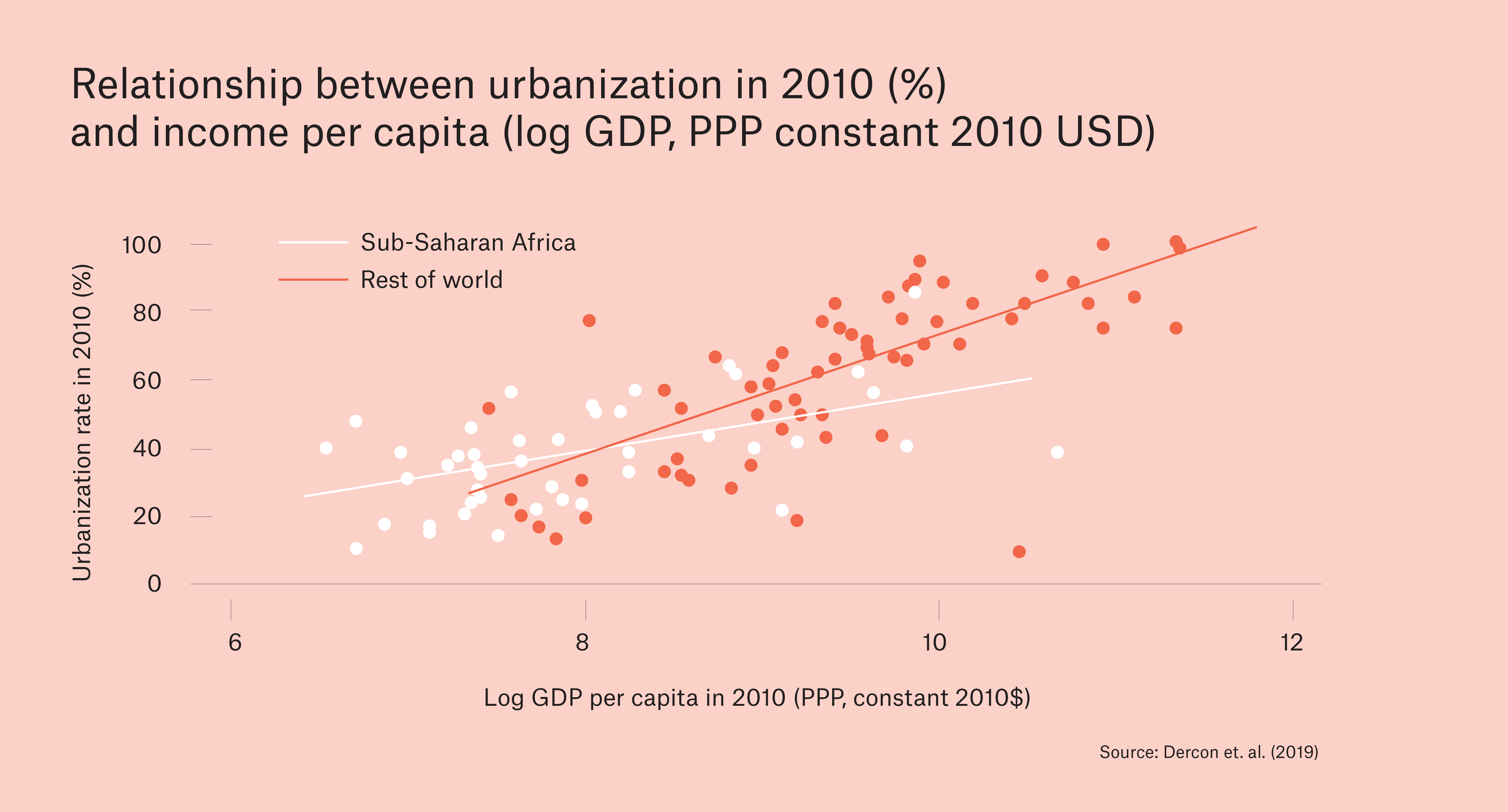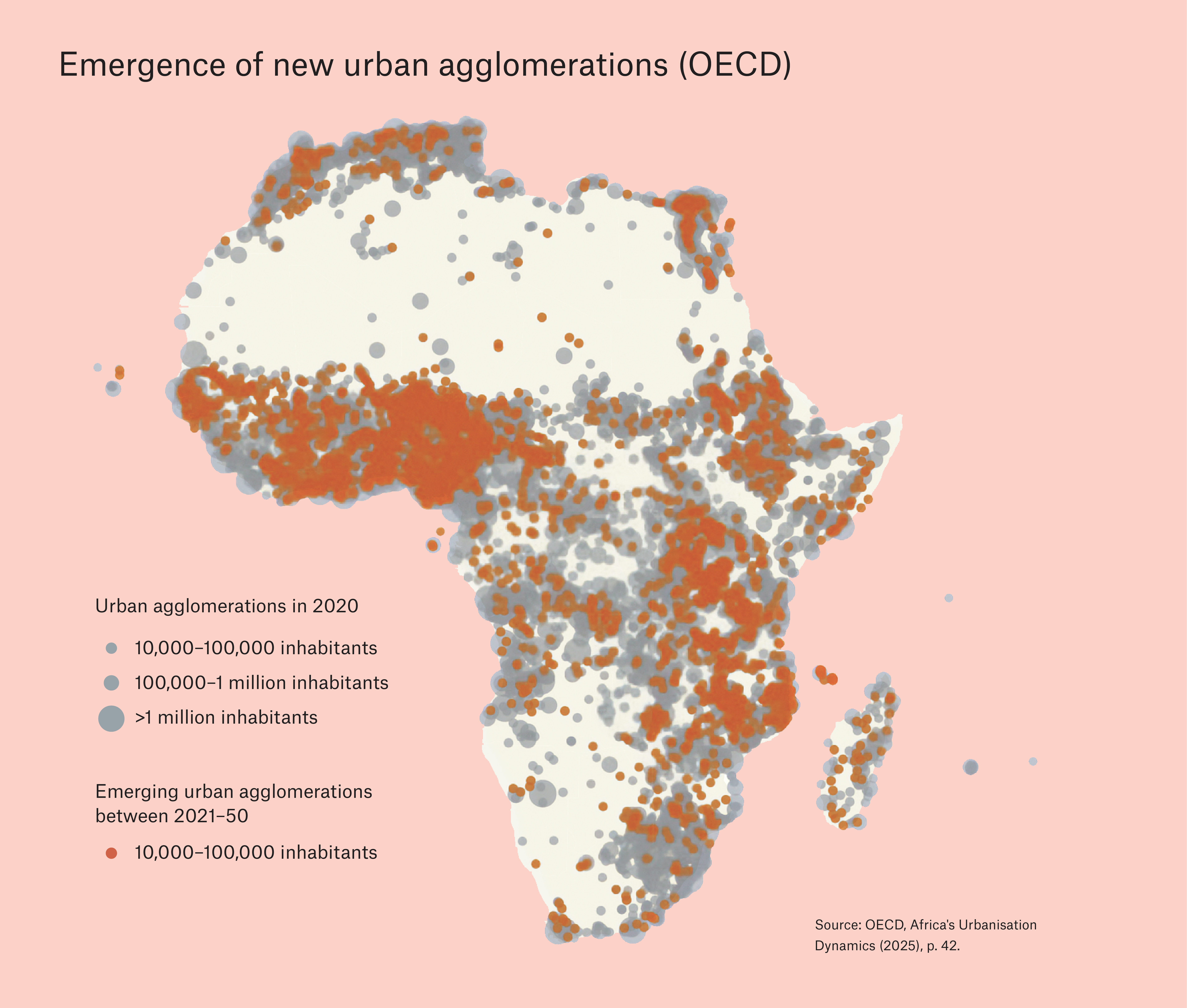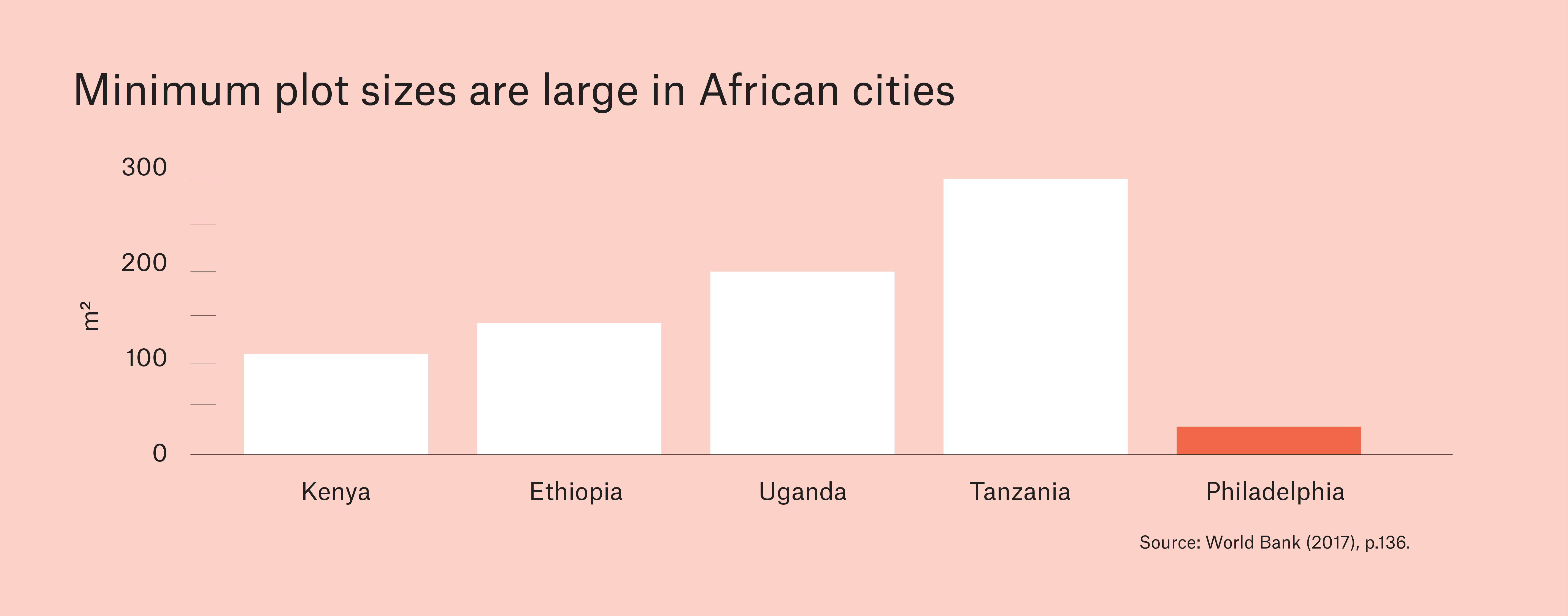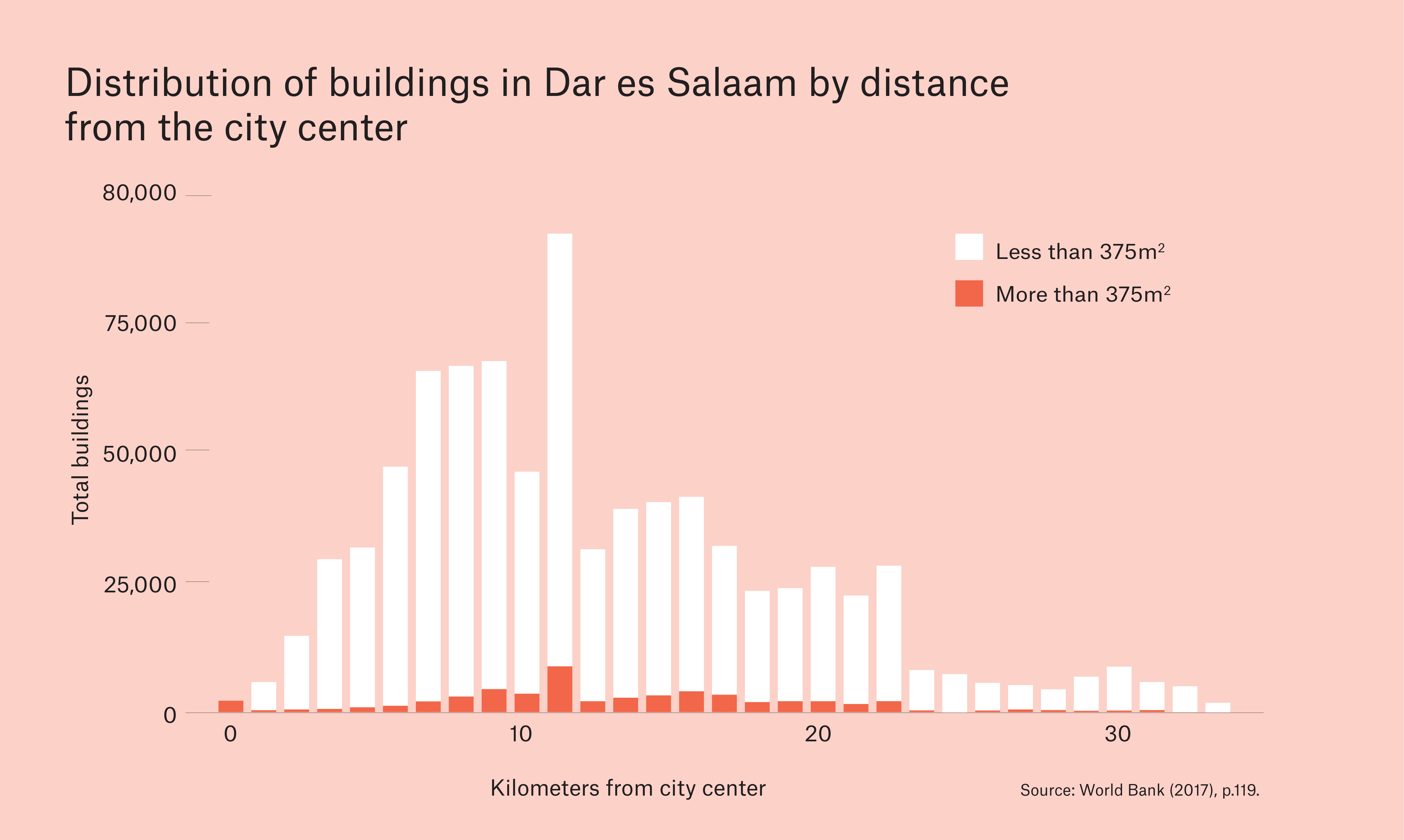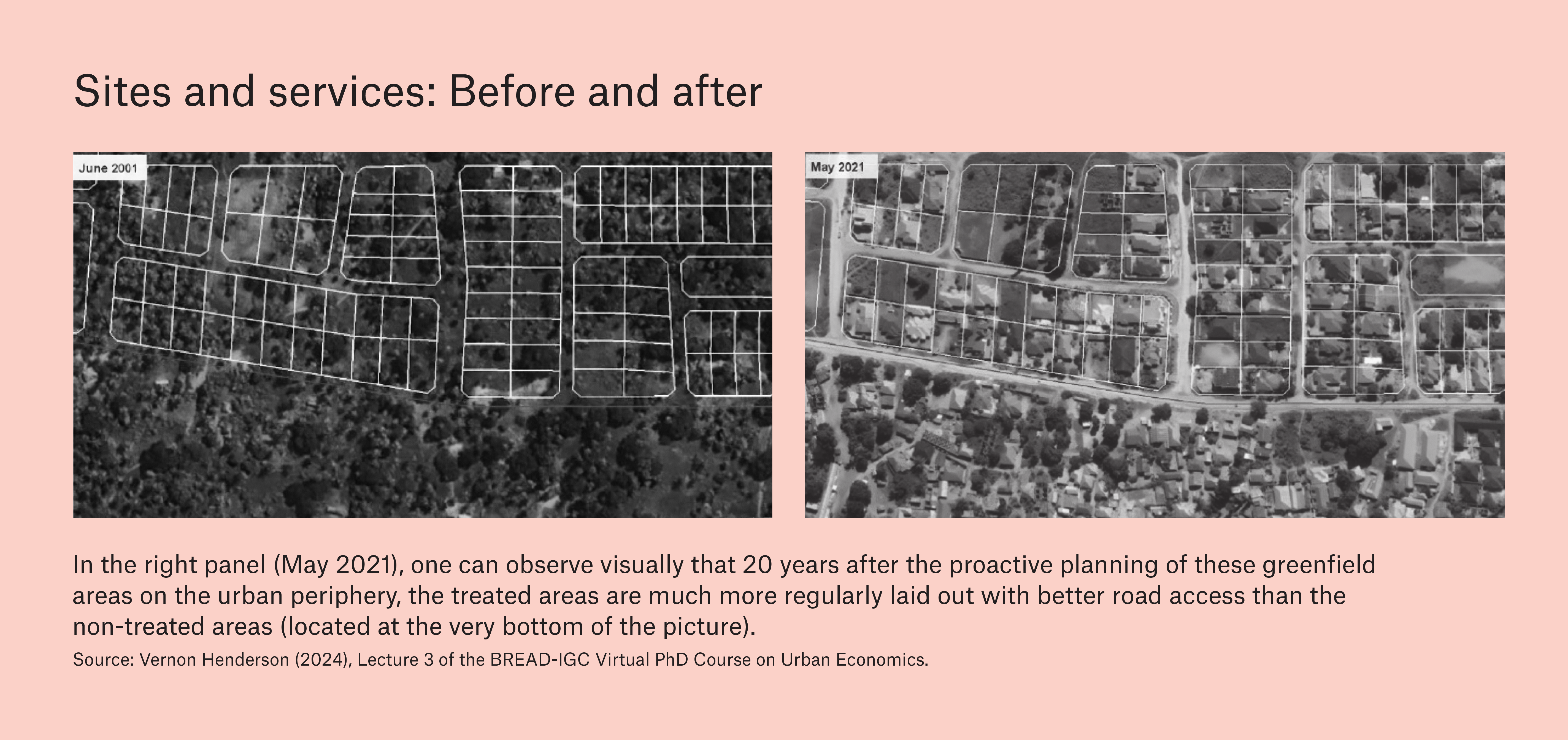YIMBYs have been winning in some of the most productive cities on Earth. Legislative victories in California and the UK have made it easier — if still not easy — to build. The logic of pro-housing reforms is both straightforward and well-supported: Fewer regulatory barriers to building mean more houses, which leads to more affordable housing and, in turn, more people able to live in dense cities that offer all the benefits of urban life.
City life makes workers smarter and more productive. Urban density spurs greater innovation and raises wages. More people concentrated in compact areas translates into significantly lower emissions per capita compared with rural and suburban areas. Cities are, in short, humanity’s engines of economic growth and prosperity. On average, with every 10% increase in the share of a country’s urban population, its output per capita increases by 30%. And there are no exceptions to this phenomenon; no country has gotten rich without undergoing urban transition.
A full 80% of private sector jobs generated between 2010 and 2020 were created in large cities.
But while this connection between cities and prosperity holds true in both rich and poor countries alike, the relationship seems to be weakening in fast-urbanizing developing countries today.
This is especially true of sub-Saharan Africa. Many African nations are reaching relatively high levels of urbanization without nearly the same income gains achieved in other regions.
A back-of-the-envelope calculation makes clear what’s at stake in the apparent decoupling of urbanization and economic growth throughout the region. If Africa’s urbanization yielded the same growth dividends as urbanization did in East Asian countries between 2002 and 2018, we would expect its GDP per capita to be just over $18,000 by 2050. If, however, Africa’s urban transition continues on its current growth trajectory, the average African’s income will be only $10,300 by 2050. Finding a way to ensure that Africa’s growth trajectory parallels East Asia’s would mean a continent nearly 75% richer than it’s expected to be under status quo growth trends.
That work must begin as soon as possible. Developing countries are urbanizing at the fastest rate observed in human history. Between now and 2050, for every one new urban resident added to a city in a developed nation, cities in the developing world will add 18. However, those cities will have much lower governance capacity, much smaller budgets, and arguably much more onerous legal and institutional barriers to growth. Consider the countries that rank lowest in the World Bank’s ease of doing business rankings: Somalia, Eritrea, Venezuela, and Yemen.
We can put all this together. Some 90% of urban population growth over the next two and a half decades will be in Asia and Africa. With only a few exceptions, it is even harder to build housing and urban infrastructure in African cities than it is in high-income countries. Which means that the countries most desperate for economic growth may be missing out on the opportunity to truly benefit from the agglomeration effects cities provide.
In other words, Africa needs a YIMBY movement.
African urbanization: The emergence of new cities
In the next 25 years, Africa is projected to add around 900 million new urban residents — more than the current urban population of Europe and the United States combined. The scale and speed of this growth are historically unprecedented.
It is a wave crashing upon a continent that currently lacks the capacity to absorb it. Two-thirds of the urban space that Africa is estimated to have by 2050 has yet to be built. Entire neighborhoods, whole cities, and even major metropolitan areas and mega-regions that don’t currently exist will need to soon. According to the OECD, over 4,000 new urban agglomerations will emerge across the continent by mid-century.
The majority of them are arising in the backyards of the fast-growing secondary cities — like Kisumu or Ruiru in Kenya, or Gwagwalada outside of Abuja in Nigeria, or Kasoa outside of Accra in Ghana — with fewer than 500,000 residents.
The challenge for an African YIMBY movement isn’t just to remove barriers to building new housing, but to find policies to enable the emergence of entirely new urban areas.
One major challenge to absorbing the coming wave of urbanization is that Africa is undergoing its urban transition at a historically lower level of income than happened in other countries. In 2010, when Africa crossed the 40% urbanization threshold, its average GDP per capita was just $1,481. Latin America crossed the same threshold in 1950 at a $2,500 per capita GDP, East Asia in 2000 at $5,400, and the United States in 1900 at $4,500. Africa is “urbanizing while poor.”
This means that many fast-growing cities across the continent lack the tax base to pay for essential urban infrastructure like roads, housing, power, and water and sanitation. It also means the governance capacity of most African cities is severely constrained. Consider that Accra spends $25 per resident every year. Nairobi spends about $56. New York, Los Angeles, and Chicago, in contrast, spend an estimated $5,437 per resident annually.
To make things worse, barriers that would be very familiar to YIMBYs in high-income countries are supercharged in African cities. Low governance capacity translates into a web of planning regulations, zoning laws, building codes, construction permitting processes, and land use restrictions that are often either over-zealous, nonsensical, selectively weaponized for political purposes, or otherwise completely ignored. Take Dar es Salaam, the largest city in Tanzania and the second-fastest growing city in the world.
Until 2018, the minimum plot size in Dar was set at 400 square meters, over 10 times that of Philadelphia when it was being rapidly settled.
Any resident who wants to own a formal home in and around Dar must be able to pay for a plot of at least 300m2. Those who can’t afford these costs (or want to avoid these costs) but still want to live in the city basically have four options. The first is city slums. Poorer residents are too often forced into informal settlements, where, depending on the data source, it’s estimated some 50% of Tanzania’s urban population lives.
Second, households are forced to crowd multiple families into one of these plots in order to boost affordability. Almost a third of Dar residents live with at least three people to a room.
Third, if residents believe themselves politically connected enough to safely flout the regulations (or are simply willing to roll the dice), then oftentimes these regulations are just simply ignored. And political connections are typically more readily available to more well-off residents. In Dar, its ridiculously high minimum plot size requirements make the vast majority of the city’s buildings “de facto illegal, regardless of formal land title or the quality of the structure.”
Finally, if residents don’t want crowding and still desire formality, they’re pushed farther and farther away from the city, to where land is cheaper. This means access to transport is a must. In Dar, as in many African cities, transportation costs are high and commute times slow. Households in Dar’s poorest quintile must spend, on average, 53% of their budgets for a motorized round-trip commute, meaning many are either restricted to short commutes or are forced to walk.
The result is that household heads in Dar commute 6 kilometers on average, severely limiting access to urban jobs. This effectively means Dar’s potentially powerful labor market of over eight million people (and growing!) is fragmented into myriad separate villages with overly localized labor markets, blunting the benefits of agglomeration. Compare this fragmentation with, for example, Chicago in the 19th century, where four-fifths of the city’s jobs were concentrated within just four miles of Madison Street and State Street (home to some of Chicago’s main residential areas at the time).
High costs of living and fragmented transportation in Dar are not merely borne by individual households. Firms suffer, too, as those located in these cities must pay higher wages to cover the exorbitant urban living costs. Unit labor costs in Dar, for example, are 20% higher than in Dhaka, Bangladesh. It’s no wonder, then, that a lot of African countries are experiencing urbanization without industrialization — in many cities it’s just too costly for firms to remain competitive and scale.
The example of Dar is a microcosm of the challenge of rapid urbanization across the continent. Beyond minimum plot sizes, there is a host of other planning, zoning, and regulatory restrictions — many familiar to YIMBYs —- that make it difficult and costly for African cities to build. In Ghana, for example, acquiring a building permit can take 170 days — and in practice, developers say it often takes four to five years. Unsurprisingly, 76% of development in Ghana is informal. In Kenya, the building codes for Nairobi, first established during the British colonial period, were copied from the industrial town of Blackburn — including a rule requiring roofs to withstand six inches of snow (a rule only recently repealed).
Indeed, removing these kinds of onerous urban planning, permitting, and land use policies are by and large the overarching aim of YIMBYs in high-income cities. Remove them, and functioning land, labor, and capital markets in these cities respond by crowding in the needed amount of private sector investment.
Unfortunately, this just isn’t the case in most African cities. Remove Dar’s 300m2 minimum plot size regulation and you’d still have to contend with the reality that only 5% of land in Tanzania is formally registered and it takes almost 70 days to transfer property. (In OECD countries, it’s 70% and 30 days, on average). This is why an Africa-focused YIMBY movement needs to look beyond removing restrictive urban regulations. It must also focus on fixes to critical underlying factor markets in African cities — land, capital, and labor.
Africa YIMBY
Land: Proactive, bare-bones urban expansion planning
Research conducted by New York University’s Marron Institute found that in a global sample of cities, when urban population doubles, urban land area roughly triples. This rule of thumb — urban land expansion outstrips urban population growth — holds true in both high- and low-income countries.
The population of African cities is expected to more than double between now and 2050.
We should expect urban land area in African cities to also triple, and we see evidence of this already. In a sub-sample of cities between 1990 and 2015, only 23% of new urbanites settled in existing areas of a city (i.e., densification/infill), while 77% settled in newly built areas on the urban periphery (i.e., expansion).
New urban areas on the periphery will likely accommodate most of the African urban population growth between now and 2050. They need to be proactively planning and developing these areas now: It’s estimated to cost about three times more to install needed infrastructure retroactively.
We need to build it before they come.
The African context demands new ways of doing urban planning. Comprehensive master plans — the conventional method in most contexts — can take years to create and are often too complicated to be used in low-budget, low-capacity environments. In 2014, for example, Nairobi’s city’s planners partnered with the Japan International Cooperation Agency (JICA) over a seven-year period to complete a comprehensive master plan. The resulting Nairobi Integrated Urban Development Master Plan was so complex that several of the officials who drafted it expressed doubts that it could ever be implemented. Stories of overly convoluted plans collecting dust seem to be the norm. Urban expansion (UX) planning offers an alternative approach. The idea is that a basic, implementable plan is preferable to a comprehensive master plan that’s never implemented. And it is definitely better than no plan at all. It goes like this:
Urban expansion planning:
Five simple steps
1. Predict: Use data to predict the land needed for the next 30 years of urban growth.
2. Control: Identify an “Expansion Area” for the city to grow into. Merge this “Expansion Area” into the city planning area.
3. Preserve: Map environmentally sensitive areas and put them into the plan.
4. Plan: Plan a grid network of wide arterial roads in the “Expansion Area,” with 1-kilometer spacing.
5. Protect: Acquire the land for the road grid and mark the rights-of-way for these roads with trees.
Source: Lamson-Hall et al. (2018).
UX has been tested in several cities across the continent. Open Philanthropy funded a post-evaluation of NYU’s Ethiopia Urban Expansion Initiative, which implemented UX planning in 18 secondary cities across Ethiopia in the early 2010s. A decade after implementation, individuals in the treated expansion areas had incomes between 8% and 18% higher 10 years later, better access to connective road infrastructure, and significantly shorter commute times, all compared with control areas.
Similar approaches throughout urban history back up these results from Ethiopia. In the 1970s and ’80s, for example, the World Bank implemented a program called Sites and Services that proactively installed basic infrastructure (roads and rudimentary water mains) in greenfield areas on the fringes of fast-growing developing-world cities. A recent study by Michaels et al. (2021) on a Sites and Services program in several Tanzanian cities showed four to five decades later that the areas treated with this UX-esque intervention had higher-quality housing, improved electricity connectivity, and better access to water mains and roads. Moreover, these upfront investments crowded in significant private sector investment. And importantly, in the cash-constrained environment of African cities, the increase in land values arising from Sites and Services plots paid for the program’s costs multiple times over.
The urban economist Ed Glaeser was correct when he said, “I know of no pathway out of poverty and to prosperity that doesn’t run through city streets.” But his quip presupposes city streets. In Africa’s urban periphery, where the bulk of its incoming urban billion will settle, these connective city streets must be built — and fast — if cities are to fulfill their role as growth engines.
Capital: Land value capture
African cities are woefully under-resourced. Tapping external sources of capital has become increasingly difficult. Aid budgets are being slashed across the board. Closer to home, the African Development Bank has set subnational finance guidelines so restrictive that, since their publication in 2019, the bank has yet to issue a single municipal loan.
African cities are thus dependent on their own national governments to fund the bulk of their annual municipal budgets via intergovernmental transfers. But these transfers are notoriously unreliable, unpredictable, opaque, and highly politicized.
A focus on raising own-source revenue seems promising and increasingly necessary. The most common type of own-source revenue for cities across the globe is property and land taxation. The major exception is in Africa, where property taxation is grossly underutilized at a time when Africa’s rapid urban transition is resulting in whopping increases in land values.
In Kigali, for example, some parcels of land on the urban outskirts have surged in value by over 1,000-fold in the last 15 years. Some scholars estimated that a land/property tax of just 1% in Kigali could potentially yield more than $60 million annually, assuming 100% compliance rates — or roughly one-third of the city’s current annual budget of $175 million.
The problem is that most major cities in Africa are entirely without effective land value capture mechanisms. Most increases in land value thus accrue to landholders who’ve bought in the right place at the right time. Taxing land and properties would enable urban governments to capture some of the colossal value generated by rapid urbanization (value oftentimes created through the investments of these very same governments). What’s more, implementing a property tax system from scratch may be easier now than ever.
Recent advances in technology have shown great potential to simplify the identification, valuation, billing, enforcement, and payment of property taxes. Such simplified approaches meet city tax officials at their current capacity.
Freetown, the capital of Sierra Leone, recently implemented a new property tax system that leverages recent improvements in satellite imagery, which is now both high quality and relatively inexpensive. With a digital bird’s-eye view of all the properties in her city, Mayor Yvonne Aki-Sawyerr partnered with an international team that helped translate the characteristics of each property — via transparent formula — into individual bills. These could be then paid via automated billing over mobile phones. Today, the city has approximately doubled the number of assessable properties on its tax rolls, from 57,000 to 110,000 properties. Most importantly, Freetown quintupled its property tax revenues.
This approach is now being scaled-up nationally. It’s also been successfully deployed in other cities like Lagos and Hargeisa, in Somaliland.
But it's the additional multiplier effects that are potentially even more economically transformative. If the city is able to establish a track record of reliably raising its tax revenue year-on-year, it will be in a much better position to go to external capital markets to borrow. Borrowing costs, as a result of de-risked, reliable revenue streams, would likely be significantly lowered. This is a point worth lingering on. Even though Freetown quintupled property tax revenue, it still amounts to just over $1 million in a city of over one million.
Property taxation should be seen not as an end in itself to closing the urban infrastructure gap but as a means to accessing more affordable rates in external capital markets. This isn’t a silver bullet, but it holds the potential for long-term knock-on effects through enhanced borrowing.
A couple other important points are worth mentioning. First, Freetown’s revenue quintupling happened in a political environment where the mayor belongs to an opposition party. On several occasions the central government attempted to subvert the city’s tax reforms, going so far as plastering the nightly news with adverts encouraging Freetowners to not pay their property bills. Yet the reforms were still a huge success. Second, compliance rates are still low — about 30%.
This suggests that even larger revenue dividends are possible in localities with more favorable political environments.
This simplified property tax approach should be replicated by cities across the continent to significantly boost own-source revenues (and in turn catalyze additional low-cost borrowing). Mobilizing own-source revenue couldn’t be more timely, as securing any external sources of capital is going to be much more difficult for African cities moving forward.
Labor: Planning capacity & skills
City and local governments are not prepared for the breakneck speed of urban growth across the continent. Consider, for instance, that just 6% of Nigerian local government officials have access to a laptop. Those who do still often lack necessary technical tools like GIS to effectively map their growing cities, up-to-date and granular population data, and enough skilled staff to perform the day-to-day duties of an urban planning agency.
One consequence is that local governments have a limited ability to draft, update, and execute effective plans. A recent OECD report of 130 plans across 47 African countries finds that 52 failed to identify urban growth areas accurately, and 10 made no provisions for urban growth at all.
Another is that this lack of local planning capacity leaves many African cities and towns overly reliant on outside donors and expertise to help implement urban plans. Not only are these more expensive, but such support has been significantly cut around the world since January 2025.
Some of this is simply numbers. The number of urban planners per 100,000 people in the UK is about 37, and in the United States is about 12. For OECD countries, the average is 21.5. Across Africa, the average is 0.89. Quite simply, the continent needs more planners.
But it’s not quite that easy. Trained urban planners aren’t very useful if the training they receive is no good. A recent UN report reviewed urban planning curriculum in Kenya and raises some pressing quality concerns that likely resonate beyond Kenya. The University of Nairobi — Kenya’s most prestigious — has made only minor adjustments to its master’s in planning curriculum, which dates back to 1971.
Skills development and capacity building for urban professionals across Africa must be greatly increased — on both the quantitative and qualitative margins. Ultimately, a lack of competent city planners today means costlier, less productive cities tomorrow, adversely affecting the livelihoods of Africa’s next urban billion. University coalitions like the recently announced UCCC coalition
could help establish a high-quality standard for updated urban planning training for urban professionals across the continent.
Conclusion
These actions — (1) bare-bones, proactive urban planning, (2) innovative property taxation to capture rising urban land values, and (3) investments in boosting the skills and capacity of urban planners and city builders — can help unlock the three main factors of production: land, capital, and labor. Together, they could form the basis of an Africa-focused YIMBY movement, a movement sorely needed to help build new urban areas already sprouting all over the continent in the backyards of existing cities. Given the unprecedented speed and scale of African urbanization, we have less than one generation to get this right before many African cities will, in essence, be locked in. The policy choices made today about the urban form, governance, financing, and built environment that are shaping African cities will have ramifications for generations to come.



